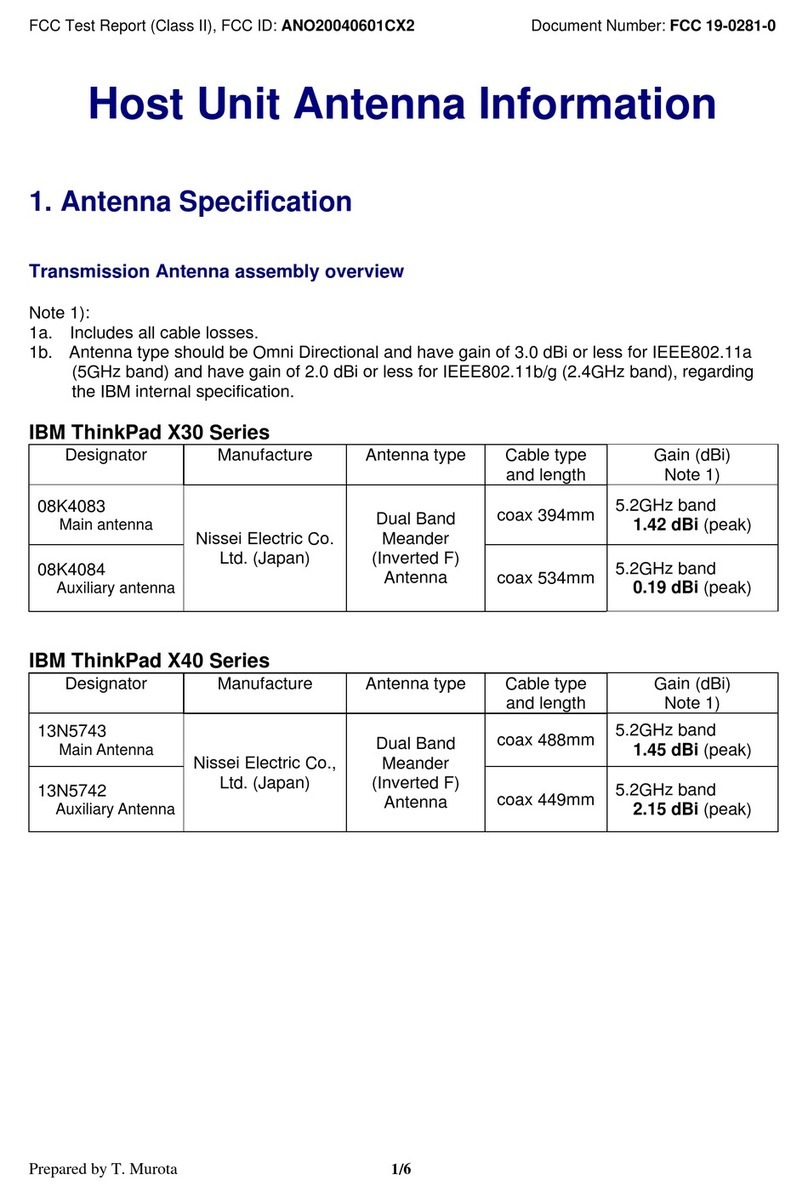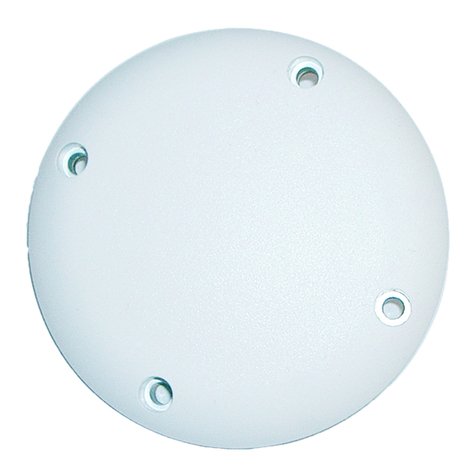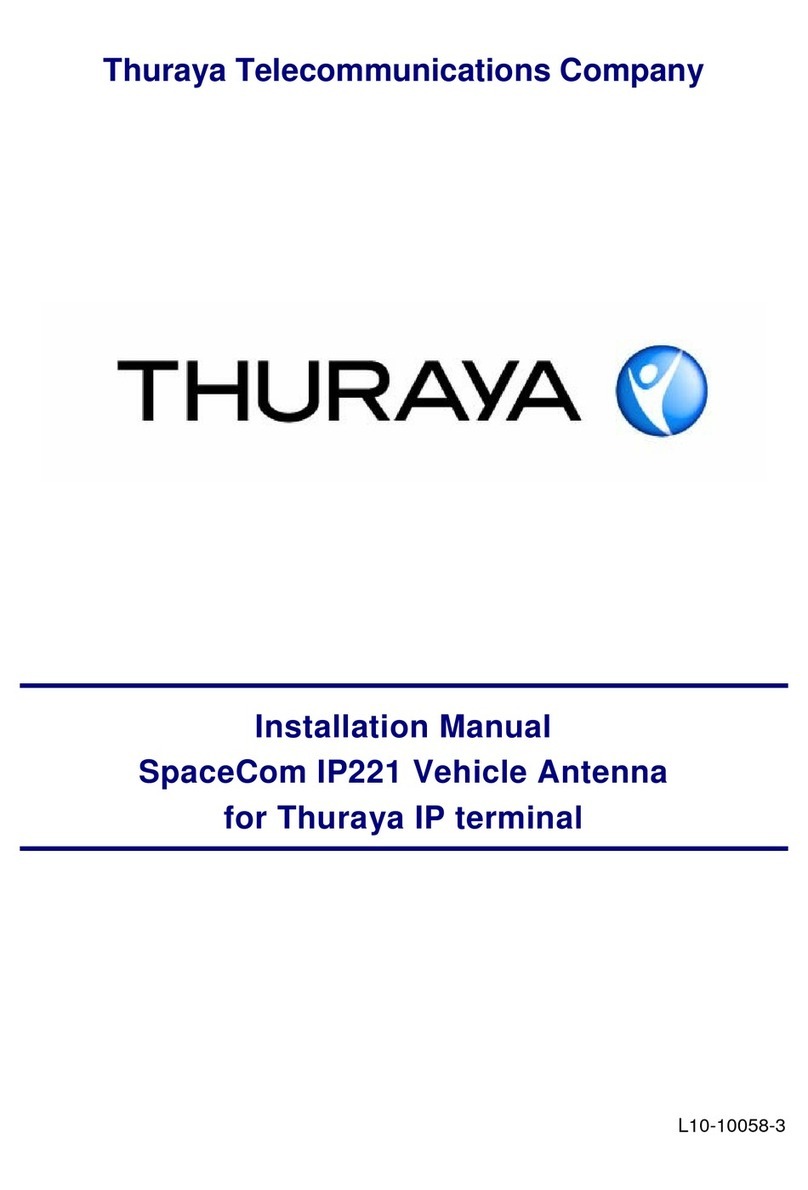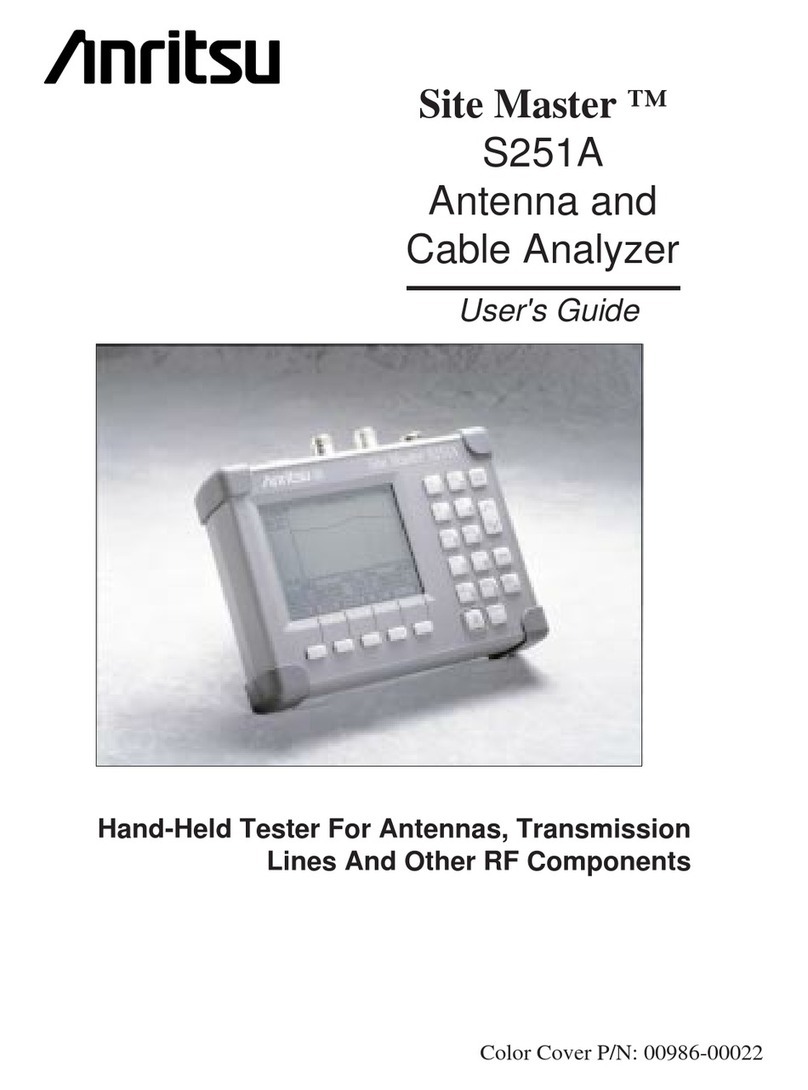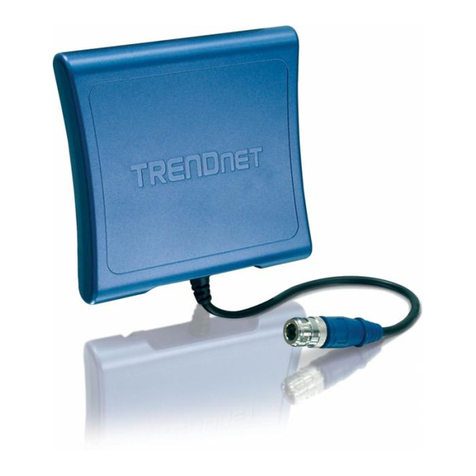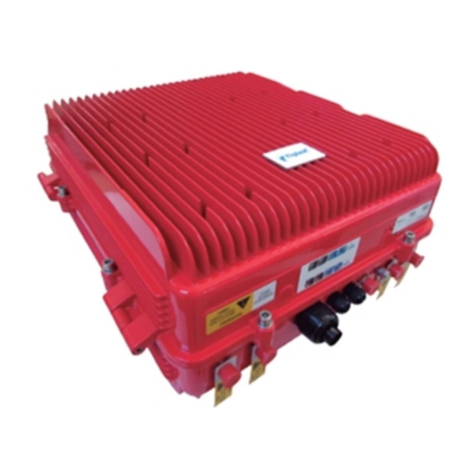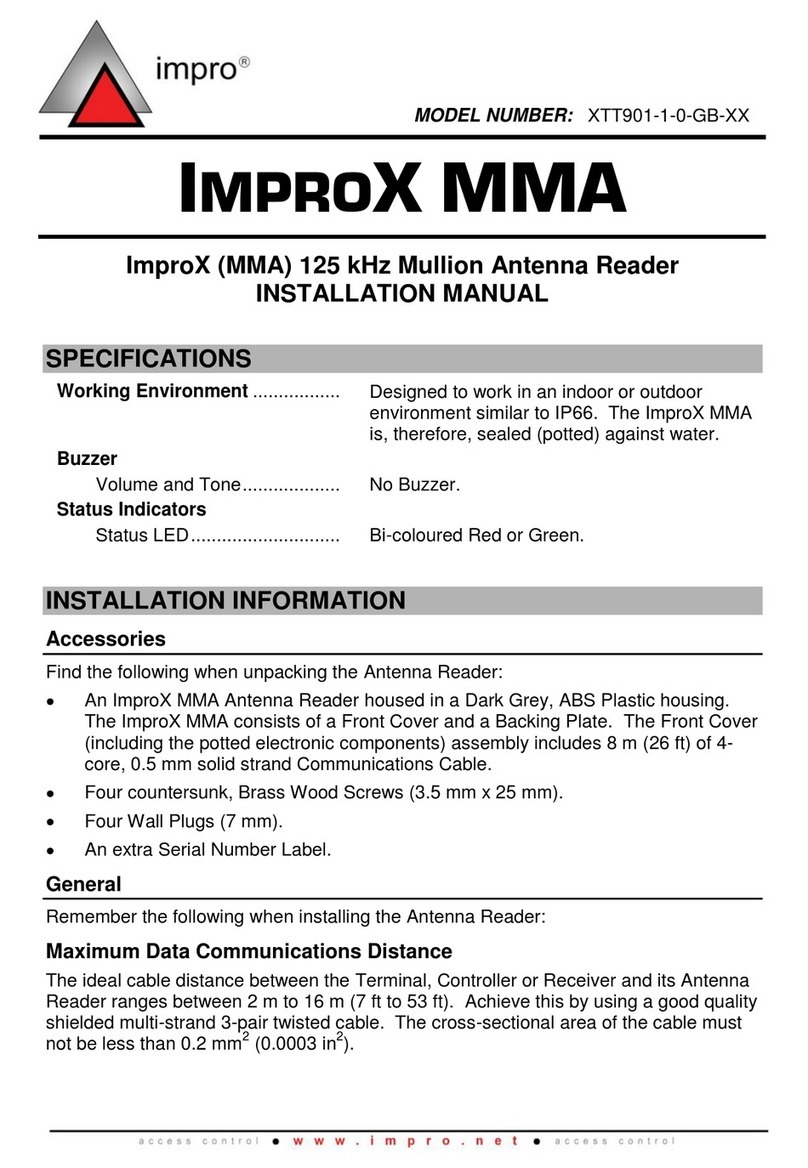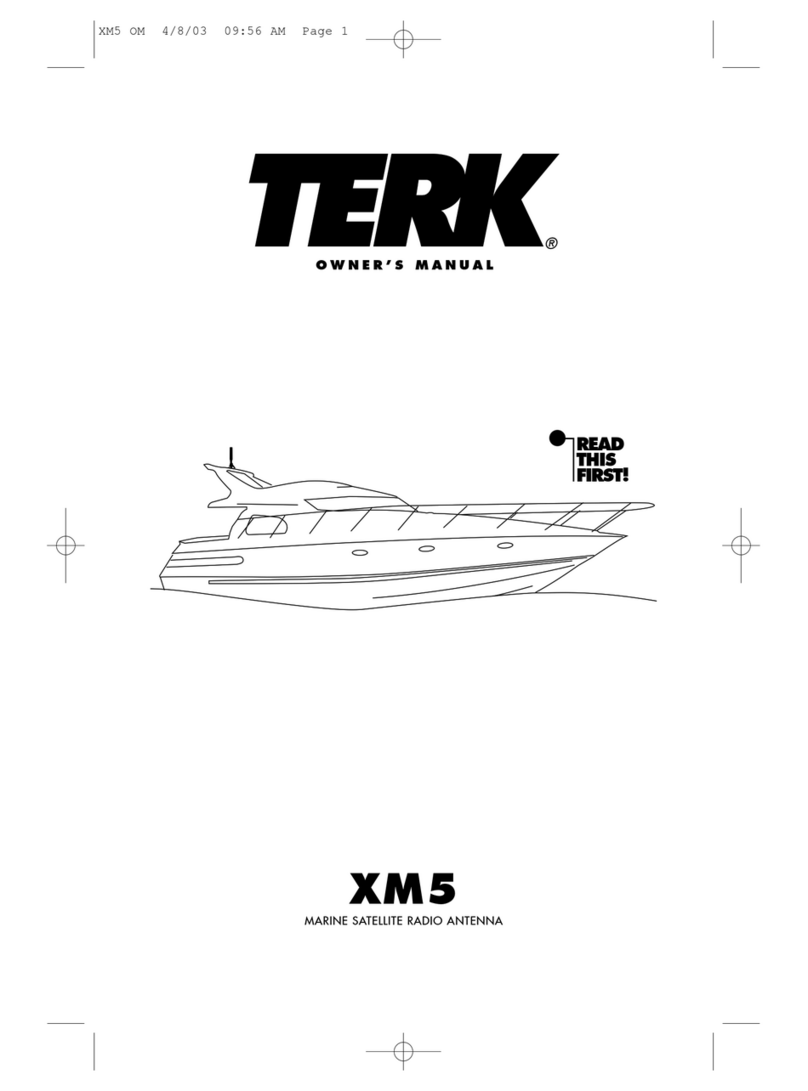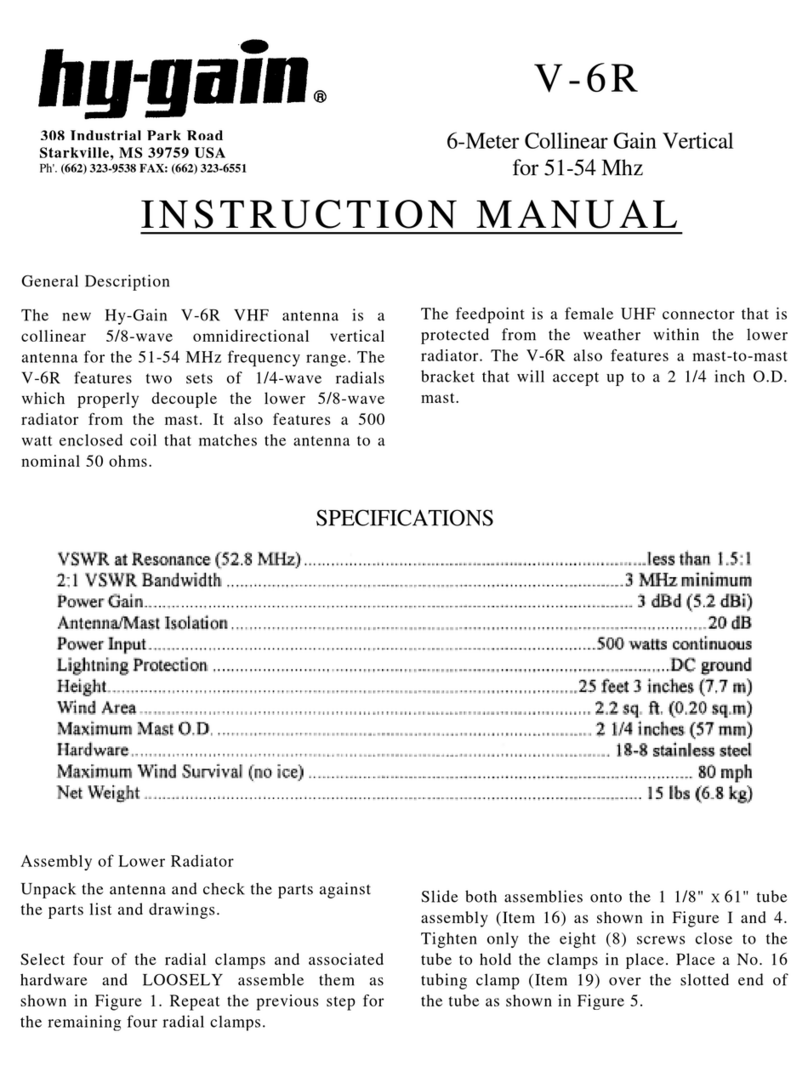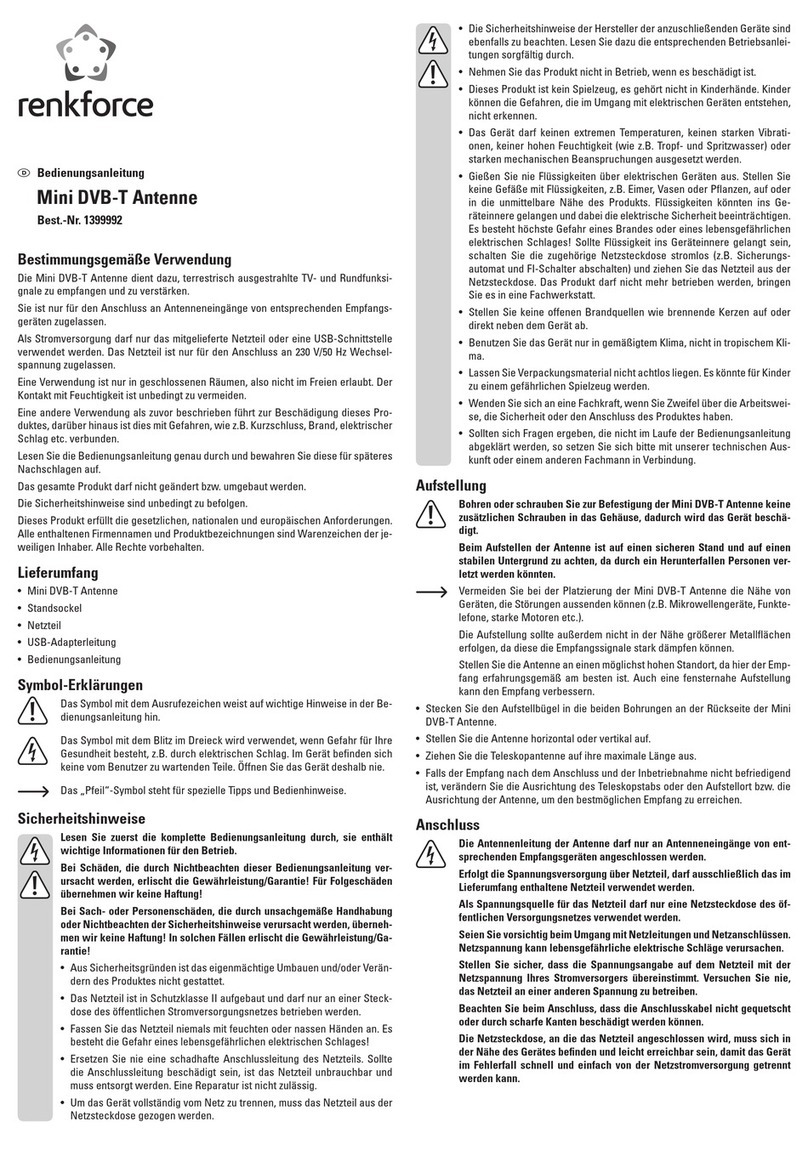Proxim Tsunami 10200 Series User manual

Tsunami®MultiPoint 10200 Series
(Point-to-MultiPoint Products)
Antenna Installation Guide
Products Covered
--> Tsunami®MultiPoint
- MP-10250-BSX

Tsunami®MultiPoint 10200 Series - Antenna Installation Guide 2
Copyright
© 2018 Proxim Wireless Corporation, Fremont, CA. All rights reserved. Covered by one or more of the following U.S. patents: 5,231,634;
5,875,179; 6,006,090; 5,809,060; 6,075,812; 5,077,753. The content described herein are copyrighted with all rights reserved. No part of this
publication may be reproduced, transmitted, transcribed, stored in a retrieval system, or translated into any language in any form by any means
without the written permission of Proxim Wireless Corporation.
Trademarks
Tsunami® MultiPoint, Proxim®and the Proxim logo are the trademarks of Proxim Wireless Corporation. All other trademarks mentioned herein are
the property of their respective owners.
Disclaimer
Proxim reserves the right to revise this publication and to make changes in content from time-to-time without obligation on the part of Proxim to
provide notification of such revision or change. Proxim may make improvements or changes in the product(s) described in this guide at any time.
When using these devices, basic safety precautions should always be followed to reduce the risk of fire, electric shock and injury to persons.
GPL License Note
Tsunami®MultiPoint products include, in part, some free software that is developed by Free Software Foundation. A user is granted license to this
software under the terms of either the GNU General Public License or GNU Lesser General Public License (See http://www.gnu.org/licenses/
licenses.html). This license allows the user to freely copy, modify and redistribute this software and no other statement or documentation from
us. To get a copy of this software, or for any other information, please contact our customer support team Telephone Support).
OpenSSL License Note
Tsunami®MultiPoint products contains software developed by the OpenSSL Project for use in the OpenSSL Toolkit (http://www.openssl.org/)
and that is subject to the following copyright and conditions:
Copyright (c) 1998-2016 The OpenSSL Project. All rights reserved.
The names “OpenSSL Toolkit” and “OpenSSL Project” must not be used to refer to, endorse, or promote the products or for any other purpose
related to the products without prior written permission. For written permission, please contact [email protected]g.
This software is provided by the OpenSSL Project “as is” and any expressed or implied warranties, including, but not limited to, the implied
warranties of merchantability and fitness for a particular purpose are disclaimed. In no event shall the OpenSSL Project or its contributors be liable
for any direct, indirect, incidental, special, exemplary, or consequential damages (including, but not limited to, procurement of substitute goods or
services; loss of use, data, or profits; or business interruption) however caused and on any theory of liability, whether in contract, strict liability, or
tort (including negligence or otherwise) arising in any way out of the use of this software, even if advised of the possibility of such damage.
Tsunami®MultiPoint 10200 Series -Antenna Installation Guide
Documentation Version: 1.0C
P/N 765-00341, April 2018

Tsunami®MultiPoint 10200 Series - Antenna Installation Guide 3
Preface . . . . . . . . . . . . . . . . . . . . . . . . . . . . . . . . . . . . . . . . . . . . . . . . . . . . . . . . . . . . . . . . . . . . . . 4
1 Antenna Installation . . . . . . . . . . . . . . . . . . . . . . . . . . . . . . . . . . . . . . . . . . . . . . . . . . . . . . . . . . . 6
Safety Precautions . . . . . . . . . . . . . . . . . . . . . . . . . . . . . . . . . . . . . . . . . . . . . . . . . . . . . . . . . . . . . . . . . . . . . 6
Installation Process . . . . . . . . . . . . . . . . . . . . . . . . . . . . . . . . . . . . . . . . . . . . . . . . . . . . . . . . . . . . . . . . . . . . 6
Required Materials. . . . . . . . . . . . . . . . . . . . . . . . . . . . . . . . . . . . . . . . . . . . . . . . . . . . . . . . . . . . . . . . . . . . . . . . . . . 7
Determining the Optimal Antenna Placement . . . . . . . . . . . . . . . . . . . . . . . . . . . . . . . . . . . . . . . . . . . . . . . . . . . . . . 8
Mounting the Antenna . . . . . . . . . . . . . . . . . . . . . . . . . . . . . . . . . . . . . . . . . . . . . . . . . . . . . . . . . . . . . . . . . . . . . . . 9
Antenna Mast Requirements . . . . . . . . . . . . . . . . . . . . . . . . . . . . . . . . . . . . . . . . . . . . . . . . . . . . . . . . . . . . . . . . 9
Antenna Tilt Angles and corresponding EIRP values . . . . . . . . . . . . . . . . . . . . . . . . . . . . . . . . . . . . . . . . . . . . . . . 9
Connecting the Cables . . . . . . . . . . . . . . . . . . . . . . . . . . . . . . . . . . . . . . . . . . . . . . . . . . . . . . . . . . . . . . . . . . . . . . 13
Connecting the Antenna Cable . . . . . . . . . . . . . . . . . . . . . . . . . . . . . . . . . . . . . . . . . . . . . . . . . . . . . . . . . . . . . 13
Connecting the Surge Arrestor and Ethernet / Power cables . . . . . . . . . . . . . . . . . . . . . . . . . . . . . . . . . . . . . . . . 14
Grounding the System . . . . . . . . . . . . . . . . . . . . . . . . . . . . . . . . . . . . . . . . . . . . . . . . . . . . . . . . . . . . . . . . . . . . 15
Sealing the Cable Connectors . . . . . . . . . . . . . . . . . . . . . . . . . . . . . . . . . . . . . . . . . . . . . . . . . . . . . . . . . . . . . . . . . 15
Aligning the Antenna . . . . . . . . . . . . . . . . . . . . . . . . . . . . . . . . . . . . . . . . . . . . . . . . . . . . . . . . . . . . . . . . . . . . . . . 18
Antenna Alignment using CLI Commands . . . . . . . . . . . . . . . . . . . . . . . . . . . . . . . . . . . . . . . . . . . . . . . . . . . . . 19
Antenna Alignment using RSSI Light Pipe . . . . . . . . . . . . . . . . . . . . . . . . . . . . . . . . . . . . . . . . . . . . . . . . . . . . . . 19
2 Measuring Signal Performance . . . . . . . . . . . . . . . . . . . . . . . . . . . . . . . . . . . . . . . . . . . . . . . . . 20
Introduction . . . . . . . . . . . . . . . . . . . . . . . . . . . . . . . . . . . . . . . . . . . . . . . . . . . . . . . . . . . . . . . . . . . . . . . . 20
Determining the Range . . . . . . . . . . . . . . . . . . . . . . . . . . . . . . . . . . . . . . . . . . . . . . . . . . . . . . . . . . . . . . . . 20
Fresnel Zone . . . . . . . . . . . . . . . . . . . . . . . . . . . . . . . . . . . . . . . . . . . . . . . . . . . . . . . . . . . . . . . . . . . . . . . . 20
Fresnel Zone Calculation . . . . . . . . . . . . . . . . . . . . . . . . . . . . . . . . . . . . . . . . . . . . . . . . . . . . . . . . . . . . . . . . . . . . . 21
Clearance Factor . . . . . . . . . . . . . . . . . . . . . . . . . . . . . . . . . . . . . . . . . . . . . . . . . . . . . . . . . . . . . . . . . . . . . 22
Calculations . . . . . . . . . . . . . . . . . . . . . . . . . . . . . . . . . . . . . . . . . . . . . . . . . . . . . . . . . . . . . . . . . . . . . . . . . 23
Calculating Link Budget. . . . . . . . . . . . . . . . . . . . . . . . . . . . . . . . . . . . . . . . . . . . . . . . . . . . . . . . . . . . . . . . . . . . . . 23
3 Warranty and Technical Support . . . . . . . . . . . . . . . . . . . . . . . . . . . . . . . . . . . . . . . . . . . . . . . . 27
Obtaining Technical Service and Support . . . . . . . . . . . . . . . . . . . . . . . . . . . . . . . . . . . . . . . . . . . . . . . . . . . 27
Support Options . . . . . . . . . . . . . . . . . . . . . . . . . . . . . . . . . . . . . . . . . . . . . . . . . . . . . . . . . . . . . . . . . . . . . 27
Additional Information on ServPak Options . . . . . . . . . . . . . . . . . . . . . . . . . . . . . . . . . . . . . . . . . . . . . . . . . 28

Preface
Tsunami®MultiPoint 10200 Series - Antenna Installation Guide 4
Preface
About this Guide
The guide gives an insight on how to set up and install the outdoor antenna(s) for the Tsunami®MultiPoint 10200 Series
products tabulated below:
Who Should Use This Guide
At a basic level, the person referring to this guide should meet the following pre-requisites:
•A professional experienced in mounting outdoor antennas, installing surge arrestors, installing and configuring
network components.
•Have a working knowledge on installation procedures for network operating systems like Microsoft Windows.
However, Proxim recommends only a qualified antenna installation professional to install the antennas and follow the
following guidelines:
•The outdoor antennas should be mounted only on an antenna tower, on a roof, or on the external surface of the
building.
•The site pre-requisites must be verified by the professional, familiar with the applicable national electrical code and
with other regulations governing this type of installation, within the country of use.
•If you are not aware about the regulations that apply in your country, contact Proxim’s Warranty and Technical
Support.
•While installing the outdoor antennas, ensure to comply with the local radio regulations and use the correct cable type
and surge arrestor.
•Local radio regulations or legislation may impose restrictions on the use of specific combinations of:
— Low - loss antenna cables and outdoor antennas.
— Selected radio channels that are connected to specific outdoor antennas.
Related Documents
In addition to this guide, please refer to the following documents for Tsunami®MultiPoint 10200 Series products that are
available at Proxim’s support site http://support.proxim.com.
•Quick Installation Guide (QIG): A quick reference guide that provides essential information for installing and
configuring the device.
•Device Management Guide - A guide that gives an overview of the device user interface and explains the step-by-
step procedure to configure, manage and monitor the device by using Graphical User Interface.
•Frequency and Channel Management: This document provides Frequency Domain and Channel list information for
Proxim devices.
•Link Configuration Guide: This guide provides information and procedure for configuring the basic link
configuration parameters and security for Proxim devices.
•Bridge and Routing Guide: This guide provides information and procedure for configuring the bridge and routing
configuration parameters for Proxim devices.
Product(s) Description
MP-10250-BSX Outdoor Tsunami® Base Station Unit with BeamX Antenna, SmartScan Radio, 867 Mbps data
rate and 2x2 MIMO radio operating in 5.150 - 5.875 GHz frequency band.

Preface
Tsunami®MultiPoint 10200 Series - Antenna Installation Guide 5
•Deployment and Troubleshooting Guide: This guide is a one-stop-shop reference guide for Proxim Customer
Support Team and System Engineers to solve common issues faced in the field while deploying Proxim products.
•Hardware Installation Guide: A guide that provides a hardware overview and details about the installation
procedures and hardware specifications.
•Safety and Regulatory Compliance Guide: A guide that provides essential information on the country specific
safety and regulatory norms to be followed while installing the device.
•Antenna Recommendation Guide - A guide that gives insight on the recommended antennas for the device, along
with the antenna specifications.
•Reference Guide - A guide that gives instructions on how to configure, manage and monitor the device using
Command Line Interface.
Proxim recommends you to visit its support site http://support.proxim.com for regulatory information and latest product
updates.

Tsunami®MultiPoint 10200 Series - Antenna Installation Guide 6
1
Antenna Installation
1.1 Safety Precautions
Listed below are the safety precautions to be satisfied, prior to the outdoor antennas installation:
•Outdoor antennas and antenna cables (good conductors of electricity) should be installed properly to avoid the
transients or electrostatic discharges (that occur due to lightning during thunderstorm) from damaging your
equipment and causing personal injury or death to the persons touching the exposed metal connectors of the
equipment.
•When installing, disconnecting, or replacing one of the cable components, ensure that each of the exposed metal
connectors of the antenna cabling system are grounded locally.
•Do not install the antenna, where there is a possibility of contact with the high-voltage arc-over from the power
cables or service drops to the buildings. Ensure that the antenna-mast or antenna-tower are not close by any power
line, during the installation or removal of antennas.
•Apply a Danger label on a plainly visible area of the antenna support structure.
•Do not climb the rooftops during a thunderstorm, in wet or windy conditions, or on the equipment installation area
which is covered with ice or snow.
•Do not touch the antennas, surge arrestors, or antenna cables during a thunderstorm.
•Install the antennas at a safe distance (at least twice the height of the antenna-mast plus the antenna) from power
lines or telephone lines.
•Mount the antennas at a safe distance, avoiding any human contact during the normal equipment operation.
•Humans should ensure 50 cm separation from the antenna (8 inches), avoid the possibility of exceeding the FCC radio
frequency exposure limits, during the normal operation of the equipment.
•Verify that the low-loss antenna cable used to connect the antenna with the surge arrestor, or the ethernet cable
used to connect the surge arrestor, are at least 1 m (3 ft.) away from any high voltage current cable.
•Check whether the antenna mast and its guy wires or wall bracket are positioned correctly and secured properly to
the roof or walls. Also, ensure that the base area, where the antenna-mast is mounted is weatherproofed.
•Ensure, that the grounding system for the antenna mast and the surge arrestor have been installed. The grounding
system must comply with the local electrical code and other requirements. See Grounding the Antennas.
•Always consult an experienced electrician to assure that the antenna mast, surge arrestor, and the equipment
hardware are grounded properly.
•The antenna cable between the antenna and the surge arrestor should be grounded. Ensure that the exposed metal
connector of the cable is grounded locally, if the cable is disconnected at one end (disconnected to replace the surge
arrestor).
1.2 Installation Process
Follow the following step-by-step procedure to install outdoor antennas:
1. Ensure that all the materials, essential to install the outdoor antennas are acquired. See Required Materials.
2. Once you have acquired all the required materials, refer Quick Installation Guide (that comes along with your product)
to mount the outdoor equipment and begin the outdoor antenna installation.
3. Verify the optimal antenna placement, maintaining a clear line-of-sight. See Determining the Optimal Antenna
Placement.
4. Mount the antenna to the support structure, following the guidelines as described in Mounting the Antenna.
5. Verify that the device, support structure for antenna (antenna-mast) and entire cable set-up for the antenna are
connected properly. See Connecting the Cables.
6. Connect the antenna cable to the antenna. See Connecting the Antenna Cable.

Antenna Installation
Tsunami®MultiPoint 10200 Series - Antenna Installation Guide 7
7. Ensure that the cabling of ethernet / power cables and the surge arrestor is proper. See Connecting the Surge
Arrestor and Ethernet / Power cables.
8. Ensure that the antennas are grounded properly to the grounding system, satisfying the local electrical code
requirements. See Grounding the Antennas.
9. Once the antenna is properly positioned, grounded and the outdoor cable setup is verified, secure all the cables and
use weatherproofing tape to seal all the outdoor connectors. See Sealing the Cable Connectors.
10. Make sure that the outdoor antennas at both the ends maintain the same antenna polarizations.
:For easy outdoor antenna installation, note the following:
•Go through the Safety Precautions.
•Read all the requirements outlined in this chapter. See Required Materials.
•Familiarize yourself with the antenna and the radio-specific mounting instructions, prior to climbing any roof or
ladder.
•Verify that you have arranged all safety measures for outdoor installation or rooftop installation. See Safety
Precautions.
•Test all the equipment before beginning the actual rooftop installation, to determine if all the required equipment is
functioning properly.
•Install the grounding system for the antenna mast, device, and surge arrestor before connecting the cables. This
protects your system against lightning strikes during installation.
•When you remove or relocate the antenna, verify the Required Materials and Safety Precautions, before you
restart the installation process, and follow the above steps in exactly the reverse order.
1.2.1 Required Materials
The outdoor installation of the equipment and the antennas, require the following:
•An outdoor radio unit.
•An outdoor antenna, supporting the local electrical code.
•A low-loss antenna cable.
:We recommend you to use a coaxial antenna cable (P/N CBL-5054-600-6), that is available with your
distributor.
•Antenna mast or wall bracket for the antenna/device.
•A grounding system that meets the local electrical code. See Grounding the System.
•Weatherproofing kit for sealing all the cable connections. See Sealing the Cable Connectors.
•Tools and material to mount the antenna. See Mounting the Antenna.
•Tape or wraps to attach the antenna cable to the mast.
•Ethernet cable (RJ 45 cable / Cat5e ethernet cable) with waterproof cap.
•Proper tools for system installation.
•Ethernet Surge Arrestor and Surge Protector (RF-cable). See Connecting the Surge Arrestor and Ethernet / Power
cables.
Ensure that you have acquired all the materials listed above, to begin with the outdoor antenna installation. Refer to the
Quick Installation Guide, that comes along with your product, for details on mounting the outdoor equipment.

Antenna Installation
Tsunami®MultiPoint 10200 Series - Antenna Installation Guide 8
1.2.2 Determining the Optimal Antenna Placement
To achieve the maximum throughput, the outdoor antenna must have clear line-of-sight with the antenna at the other end.
The outdoor antennas are said to have a clear line-of-sight, when there are:
•No obstacles in the direct path between the antennas (antenna beam)
•No obstacles within a defined zone around the antenna beam
Although, the radio signal can work well without the clear line-of-sight in urban environments, where the signal is
transported by reflection rather than transporting it directly along the obstacles. The following figure shows some typical
examples of obstacles you must avoid in urban environments, for the directional antenna to operate effectively.
Figure 1-1 Obstacles to be avoided: (a) Neighbouring Buildings (b) Tall Trees (c) Power Lines
To minimize the signal interference or reflections due to obstacles, note the following guidelines:
•Mount the antenna as high as possible above the ground to allow maximum clearance.
— In open areas, ‘ground’ is the actual surface of the earth.
— In dense urban areas, ‘ground’ is to be interpreted as the height of the highest obstacle in the signal path
between the two antenna sites.
•Avoid trees in the signal path to avoid signal absorption due to seasonal changes (leaves or ice).
•Install the antenna at least 2 m (6 ft.) away from all other antennas.
Other situations in which reflections of the radio signal may cause interference are environments with large reflecting
surfaces, parallel or partly perpendicular to the antenna beam, such as:
•Mirror-glass buildings.
•Crowded parking lots.
•Water surface, moist earth and moist vegetation.
•Electric power lines and telephone lines above the ground level.
:Reflective surfaces can be used to improve the performance of a link, if the direct line-of-sight is impaired or absent.
In the absence of a direct path or clear line-of-sight, transporting a signal through reflection depends on two factors:
•Fresnel Zone: It is required to calculate the distance of the obstacle from the antenna. See Fresnel Zone.
•Clearance Factor: It is required for optimal performance (See Clearance Factor). Ensure that the type and placement
of the antennas leave sufficient clearance of the Fresnel Zone at the maximum width of the bulge, which is typically at
the mid-point between the antennas.

Antenna Installation
Tsunami®MultiPoint 10200 Series - Antenna Installation Guide 9
1.2.3 Mounting the Antenna
Mounting an antenna directly to the wall does not let you align the antenna properly with the corresponding antenna at the
opposite end of your wireless link. Poor antenna alignment typically results in poor performance and therefore, we
recommend mounting the antennas to a mast.
The two methods followed frequently to erect an antenna mast are:
•Tripod Mount: The tripod mount is used primarily on peak and flat roofs. The antenna mast must be secured to the
roof using three or four guy wires equally spaced around the mast. When the height of the antenna mast is more than
3 meters (10 ft.), you should use at least three guy wires for every 3-meter (10-foot) section of the mast.
•Wall (Side) Mount: A wall (side) mount allows you to mount the antenna (mast) on the side of a building or on the
side of an elevator penthouse. This provides you with a convenient mounting location, when the roof overhang is not
excessive or when the location is high enough to provide a clear line-of-sight.
When mounting multiple antennas on a single mast, use the following methods to minimize the influence of cross-talk
interference between the antennas:
– Place your antennas as far as possible.
– Mount the directional antennas, such that the identical side of both the antennas face the same direction.
:As the mounting procedures for the various antennas differ from one another, refer to the guide that comes along
with the antenna.
1.2.3.1 Antenna Mast Requirements
To accommodate the antennas, the antenna mast must satisfy the following requirements:
•The construction of the antenna mast must contain sturdy, weatherproof, and non-corrosive material (for example,
galvanized or stainless steel construction pipe).
•Diameter of the mast should be between 35 mm (1.4 inches) and 41 mm (1.6 inches). The diameter of the antenna mast
vary depending on the type of antenna you intend to install.
•The height of the antenna mast must be high enough to allow the antenna to be installed at least 1.5 m (5 ft.) above the
roof. The height of the antenna should be at least 3 m (10 ft.) above, if it is a metal roof.
•The antenna mast or wall bracket must be free from any material (like paint) that prevents a good electrical conduction
with the antenna.
1.2.3.2 Antenna Tilt Angles and corresponding EIRP values
:The below mentioned particulars are applicable only to the devices operating in U-NII-1US frequency band
5.15 GHz - 5.25 GHz.
The Federal Communications Commission (FCC) established new rules for the 5.15 GHz - 5.25 GHz U-NII-1 band in the
Report and Order FCC-14-30A1 are effective from June 2nd, 2014. With the help of professional installation, all the Proxim
devices can be configured to comply with the power requirements set in the rules. For an angle of elevation which is above
30 degrees, the maximum EIRP limit should be set to 125 mW (21 dBm). The compliance can be achieved through proper
selection of antenna, angle of elevation, and Tx power control to provide reasonable protection from harmful interference to
users, authorized devices, and co-channel NGSO/MSS operations.
: The antennas installed at both the ends of a wireless link should maintain same antenna
polarizations.

Antenna Installation
Tsunami®MultiPoint 10200 Series - Antenna Installation Guide 10
The antenna/devices located at different altitudes should be tilted at the correct angle to efficiently transmit/receive the
signals between the devices in the wireless network. The following figure shows the antenna tilt and its importance when the
successive devices are located at different elevations above the ground.
Figure 1-2 Typical installation showing device/antenna tilt angle
The radiation patterns for a device with Horizontal polarized antenna in Azimuthal and Elevation planes are shown below
in Figure 1-3.As per the regulatory domain, there are no limitations to the Azimuthal plane with respect to EIRP, but the
Elevation plane has a limit specific to EIRP above 30 degrees as 21 dBm. To comply with this specification, Proxim products
have an option to control the transmit power based on the installation tilt angle and the radiation pattern of the antenna.
Figure 1-3 Antenna radiation patterns for Azimuthal and Horizontal Planes
The formula used for the calculation of Transmit Power is given below:
Transmit Power = EIRP - G (30- 0) - MIMO Gain
Where,
EIRP - Equivalent Isotropically Radiated Power
G (30- 0) - Antenna gain at (30- 0) in the elevation plane
MIMO Gain - Gain for Multi Input Multiple Output products (2x2 MIMO Gain is 3 dB and 3X3 MIMO Gain is 4.8 dB)
•The calculation of Transmit Power to comply with the EIRP limits for an antenna with a gain of 22 dB is explained below
for three different tilt angles:
•Case 1: 0 = 00 (No antenna tilt)

Antenna Installation
Tsunami®MultiPoint 10200 Series - Antenna Installation Guide 11
– The antenna gain for 0= 00is shown in the following figure:
Figure 1-4 Antenna gain at (30- 0) = 300
– Transmit Power = EIRP - G (30- 0) - MIMO Gain
= 21 - 5 = 16 dBm
•Case 2: 0 = 150 (antenna tilted upward)
– The antenna gain for 0= 150is shown in the following figure:
Figure 1-5 Antenna gain at (30- 0) = 150

Antenna Installation
Tsunami®MultiPoint 10200 Series - Antenna Installation Guide 12
– Transmit Power = EIRP - G (30- 0) - MIMO Gain
= 21 - 10 = 11 dBm
•Case 3: 0 = -150 (antenna tilted downward)
– The antenna gain for 0= -150is shown in the following figure:
Figure 1-6 Antenna gain at (30- 0) = 450
– Transmit Power = EIRP - G (30- 0) - MIMO Gain
= 21 - 0 = 21 dBm
:
•-10 degree indicates that the antenna is tilted downwards.
•10 degrees indicates that the antenna is titled upwards.
Tilt Angle
(degrees)
Allowed Transmit Power per
Single chain (dBm)
EIRP of Product
(dBm)
Remarks
01237
-10 13 42
-20 13 38
-30 17 42
10 10 35
20 10 35
30 -5 21 Not Recommended

Antenna Installation
Tsunami®MultiPoint 10200 Series - Antenna Installation Guide 13
1.2.4 Connecting the Cables
Once the outdoor antennas are properly mounted, the cable setup essential to complete the outdoor antenna installation is
depicted in the following figure:
Figure 1-7 Cable Setup
The entire outdoor cabling setup requires the following cabling to be done:
1. Connecting the Antenna Cable
2. Connecting the Surge Arrestor and Ethernet / Power cables
3. Grounding the System
1.2.4.1 Connecting the Antenna Cable
Follow the following steps to connect an antenna to the device, by using an antenna cable.
1. Use an RF cable (antenna cable) to connect the outdoor device to an external antenna.
2. Connect the right-angled N-male connector of RF cable on the antenna. The antenna cables run from the external
antenna to the N-Type connectors on the device. The N-Type connectors have built-in surge protection.
3. Secure the antenna cable to the antenna mast, as the cable connectors do not support the full weight of the cable.
4. Connect the other end of the antenna cable to the device.
: Do not use tools to tighten the cable connectors, as they damage the antenna cable and connectors.

Antenna Installation
Tsunami®MultiPoint 10200 Series - Antenna Installation Guide 14
5. If required, adjust the direction of the antenna.
6. Tighten the nuts of the antenna to lock the antenna into its position.
7. Secure the cable along its complete length with a cable or electrical tape to relieve strain on the antenna connector. No
part of the cable should be allowed to hang free, especially the parts that are routed outside the building.
8. Weatherproof all the outdoor connectors. See Sealing the Cable Connectors.
Ensure you follow the below guidelines while using the antenna cable:
•The entire cable used must be secured and no part of the antenna cable should be allowed to hang free, precisely the
outdoor cable parts.
•The antenna cable and cable connectors are not designed to withstand excessive force.
•Do not use the connectors like ‘cable grips’, to pull the cable through raceways or conduits.
— Do not use the cable connector to support the weight of the cable during or after installation.
— Do not use any tool to tighten the connectors.
•Always seal the connectors using the weatherproofing tape.
•Avoid any water or moisture entering the cable, as it impacts the performance of the wireless link.
•Prior to sealing the outdoor connectors and permanently securing the cable to the wall with cable ties and wall hooks,
assure that the components that are installed are functioning properly.
Antenna Cable Routing
The antenna cable must be routed and fixed in such a way, that the installation technicians have a clear passage area. All the
connectors that are located outdoor must have a weatherproof seal. We recommend you to seal the connectors only after
completing the final radio test. See Sealing the Cable Connectors.
1.2.4.2 Connecting the Surge Arrestor and Ethernet / Power cables
Perform the following steps to ensure proper surge protection, and ethernet or power cabling:
•Connect the surge arrestor near the outdoor device with a CAT5e ethernet cable (properly ground it near to the cable
ingress point of the building, complying with the local electrical code requirements).
•Connect the RJ 45 Data In / LAN-IN / IN port on the POE (power injector) and the network interface card of the
personal computer with a Cat5e ethernet cable.
•Plug one end of the Cat5e ethernet cable into the ethernet port of the surge arrestor (near building ingress point) and
connect the other end of the cable to the Data & Power Out / PWR LAN-OUT / OUT port on the POE. Ensure that
the cable connector is latched securely.
•Connect the remaining ports on both the surge arrestors (one near the outdoor device and other at the building
ingress point) with an RJ 45 terminated cable.
: It is mandatory to install an approved lightening surge protector at the building ingress point. If the device is installed
in a region subjected to violent thunderstorms or severe weather conditions, then installation of an additional
: Avoid over-tightening of the connector, nuts and screws that are used to mount the antenna, to
protect the antenna and device from getting damaged.
IMPORTANT! Ensure to loop the cable before entering the premise to prevent water ingress.

Antenna Installation
Tsunami®MultiPoint 10200 Series - Antenna Installation Guide 15
approved lightening surge protector near the device is recommended. To buy an additional Surge Protector
(Part Number: 235-00001), place an order separately with your distributor.
1.2.4.3 Grounding the System
Direct grounding of the antenna mast, device, and surge arrestor is extremely important. Refer to the Quick Installation
Guide, that comes along with your product, for detailed illustration on grounding the outdoor device and surge arrestors.
:A safety grounding system is necessary to protect your radio from lightning strikes and the static electricity generated
from it.
Grounding the Antennas
Following precautions should be satisfied, while grounding the antenna:
•The antenna mast and the grounding system should be installed only by qualified installation professionals and
electrician, who are familiar with local building, safety, and electrical codes in the country of use.
•The antenna mast, the device, and the surge arrestor must be connected to the same ground, by using an equi-
potential bonding conductor.
•A good electrical connection should be made to one or more ground rods, by using at least a 10 AWG ground wire
and non-corrosive hardware.
1.2.5 Sealing the Cable Connectors
Corrosion of the antenna cable, cable connectors and other wireless outdoor installations degrade the performance of the
wireless link. To avoid, you must always seal the outdoor cable connectors using weatherproofing tape. To weatherproof the
antenna connectors at both the ends of a wireless link, follow the following step-by-step procedure:
1. Collect the required material:
The material required for weatherproofing connectors are,
•Any standard Butyl Mastic Tape
•Any standard Vinyl Tape
We have used the following Butyl Mastic Tape and Vinyl Tape as an example to demonstrate the weatherproofing steps:
2. Follow the following weatherproofing steps:
: The surge arrestor and the antenna mast must be connected to the same grounding system, by
using the shortest cable possible, as prescribed by local electrical codes.
: We have taken MP-8xxx-BSU and external antenna as an example to explain the weatherproofing
steps. Follow the same method to weatherproof the antenna connectors of the Tsunami®MultiPoint
10200 Series products.

Antenna Installation
Tsunami®MultiPoint 10200 Series - Antenna Installation Guide 16
Step 1: Wrap vinyl tape in a half-lapped fashion, from the weatherproof connector end and continue wrapping down 3
inches onto the CAT5e cable.
a. Weatherproofing at the device end:
b. Weatherproofing at the antenna end:
Step 2: Wrap a second layer of vinyl tape in the reverse direction over the first layer of tape.
a. Weatherproofing at the device end:
b. Weatherproofing at the antenna end:
(a) (b)
(a) (b) (c)
(a) (b)
(a) (b)

Antenna Installation
Tsunami®MultiPoint 10200 Series - Antenna Installation Guide 17
Step 3: Now, wrap a third layer of vinyl tape over the other two layers but with the adhesive side up as this provides a sticky
surface for the next layer.
a. Weatherproofing antenna connectors on the device:
b. Weatherproofing antenna cable:
Step 4: Next, wrap a layer of the butyl mastic tape over the adhesive side of the tape, covering all of the tape and connector.
a. Weatherproofing antenna connectors on the device:
b. Weatherproofing antenna cable:
Step 5: Wrap vinyl tape over the butyl layer and cover the entire tape assembly.
(a) (b)
(a)
(b)
(a) (b)
(a) (b)

Antenna Installation
Tsunami®MultiPoint 10200 Series - Antenna Installation Guide 18
a. Weatherproofing antenna connectors on the device:
b. Weatherproofing antenna cable:
Step 6: Place a small zip tie over the last wrap of tape to prevent it from unwrapping over time.
The figure below depicts the complete weatherproofing of the RF connection.
1.2.6 Aligning the Antenna
Antenna alignment is the process of physically aligning the antenna of the radio receiver and transmitter to establish a link
with a better throughput. The antenna alignment process is usually performed during the installation of the antennas. You
can align the antennas by using the following two methods:
•Antenna Alignment using CLI Commands
•Antenna Alignment using RSSI Light Pipe
Alternatively, consult an antenna installation service professional to optimize the antenna alignment.
(a) (b)
(a) (b)

Antenna Installation
Tsunami®MultiPoint 10200 Series - Antenna Installation Guide 19
:Applicable only to the devices with the back-haul feature (i.e., devices with 5 GHz Antennas).
1.2.6.1 Antenna Alignment using CLI Commands
To enable the antenna alignment display from the CLI prompt, enter the following commands:
•aad enable local: Enables display of the local signal, noise and SNR.
•aad enable remote: Enables display of the remote signal, noise and SNR.
•aad enable: Enables display of local and remote signal, noise and SNR.
:Use a flat blade screw driver to disconnect and pull out the serial cable from the enclosure after the antenna
alignment is done. After withdrawing the cables, seal the serial port carefully to avoid water seepage.
1.2.6.2 Antenna Alignment using RSSI Light Pipe
To assist alignment, the device can use a RSSI Light Pipe (supplied) to easily view the RSSI LEDs implemented in device’s Access
Port.
RSSI Light Pipe helps to align/adjust the antennas such that the signal between the devices is optimal. The number of RSSI
LEDs which glow in the RSSI Light Pipe as per the signal level are as below:
SNR Range (dB) Number of glowing RSSI LEDs
1 – 12 1
13 – 18 2
19 – 24 3
25 – 30 4
> 30 5

Tsunami®MultiPoint 10200 Series - Antenna Installation Guide 20
2
Measuring Signal Performance
2.1 Introduction
The performance of a microwave link (wireless link established between two outdoor antennas) is closely related to the
following factors:
•Range
•Fresnel Zone
•Clearance Factor
Calculating the above factors help you align the antennas properly and achieve a better throughput.
2.2 Determining the Range
Range is the maximum distance a microwave link travels and is based on the:
•Type of the outdoor antenna equipment (Outdoor antennas differ in technical specifications).
•Data speed of the wireless link.
•Clearance of the signal path (see Clearance Factor).
Use the following formula to determine the range of the microwave link:
Range = Maximum Range x Clearance Factor
1. Maximum Range: It is the theoretically calculated value achieved under optimal circumstances, by using the
available products and their technical specifications that comply with the local radio regulations. The calculations
made assuming the optimal radio conditions do not guarantee of achieving the same maximum distance at your
location.
2. Clearance Factor:See Clearance Factor.
Variations in calculations of the above two factors occur due to any of the following reasons:
•Incorrect alignment of antennas.
•Polarization mismatch of the antennas.
•Sources of interference or unexpected reflections in the signal path that affect the quality of communication (Refer
Determining the Optimal Antenna Placement).
•Severe weather conditions such as heavy rainfall, snow or strong winds.
•Unexpected obstacles in the link path.
•Seasonal influences such as leaves on trees or icing of the antennas.
2.3 Fresnel Zone
The narrow antenna beam emerged from the antennas contain a bulged area called as Fresnel Zone. The first Fresnel Zone is
known to be an imaginary boundary line offset along the direct path of the signal, where a signal reflected will travel an
additional one-half distance of wavelength. Each succeeding Fresnel Zone boundary adds an additional half-wavelength to
the reflected path distance than the direct signal path between the antennas.
When any significant part of the Fresnel Zone is obstructed, a portion of the radio energy is lost that results in reduced
performance. Reduced performance can also occur when obstacles close to the antenna beam cause signal reflections or
noise that interfere with the radio signal.
Weather conditions (rain or snow) usually do not have much impact on the performance of your device, provided you have
sealed all the cable connectors with weatherproofing tape. Seasonal influence on signal propagation can occur in the
following situations:
This manual suits for next models
1
Table of contents
Other Proxim Antenna manuals
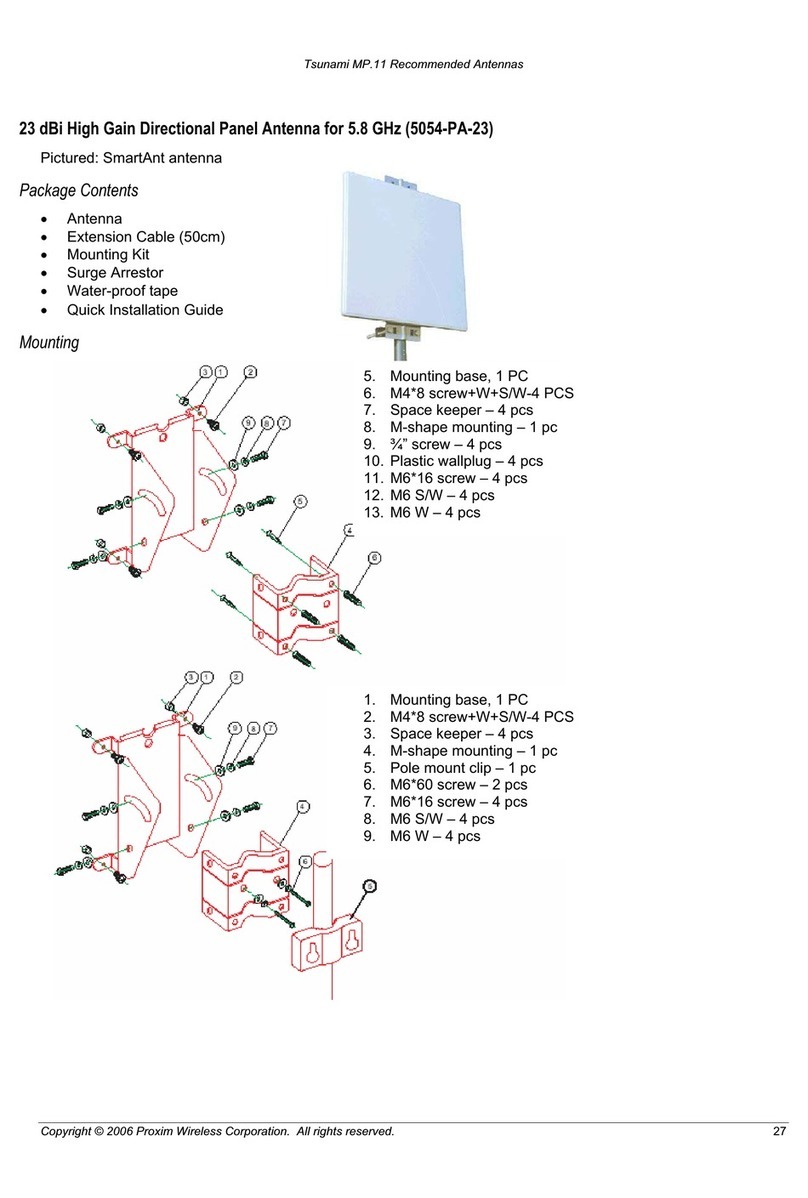
Proxim
Proxim 5054-PA-23 User manual

Proxim
Proxim Antenna Tsunami MP.11 User manual

Proxim
Proxim Antenna Tsunami MP.11 User manual
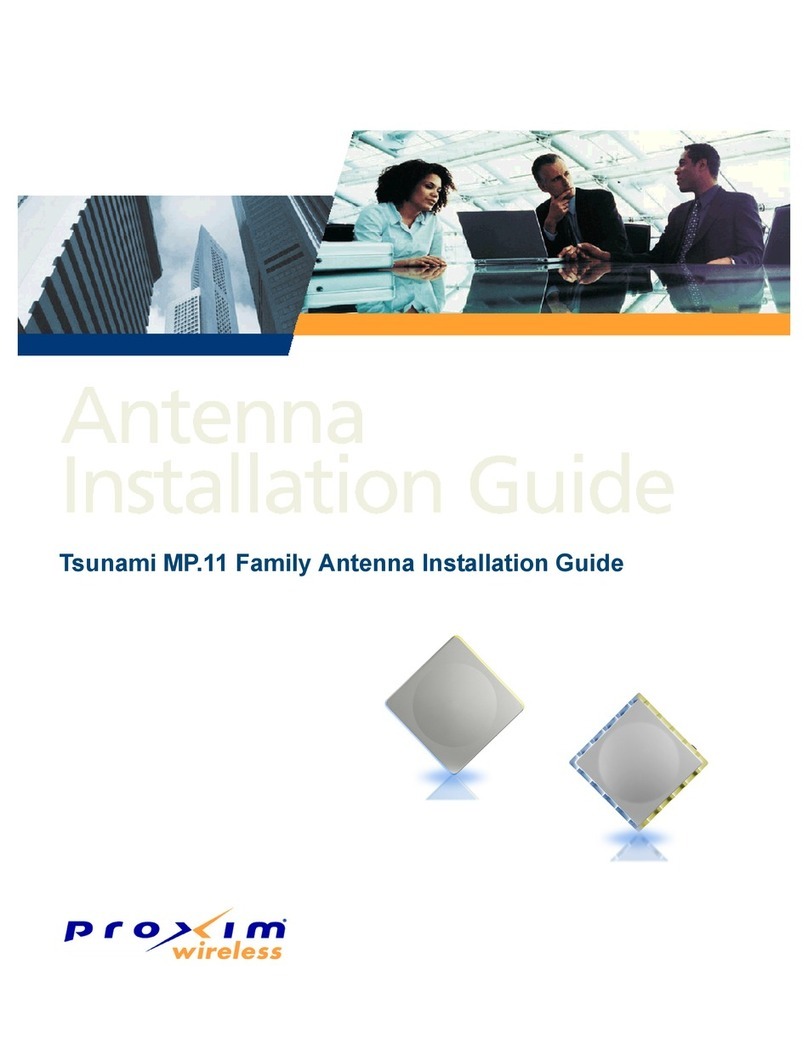
Proxim
Proxim Antenna Tsunami MP.11 User manual

Proxim
Proxim Antenna Tsunami MP.11 User manual
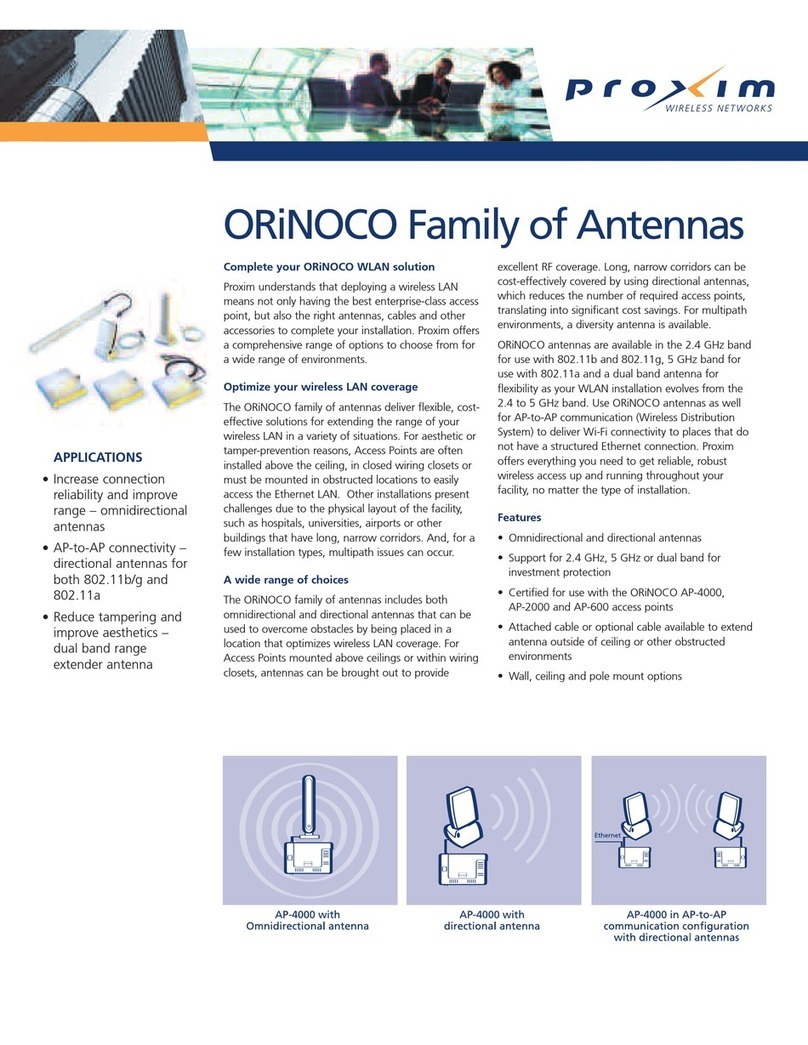
Proxim
Proxim ORINOCO AP-2000 User manual
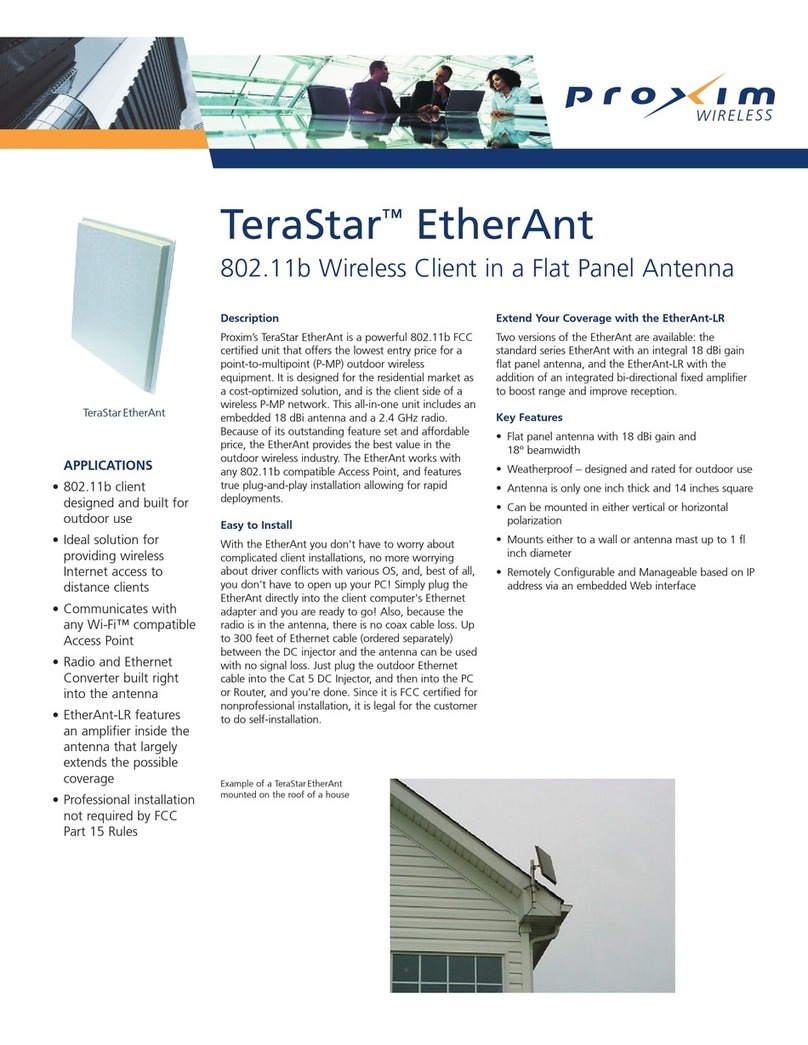
Proxim
Proxim TeraStar EtherAnt User manual
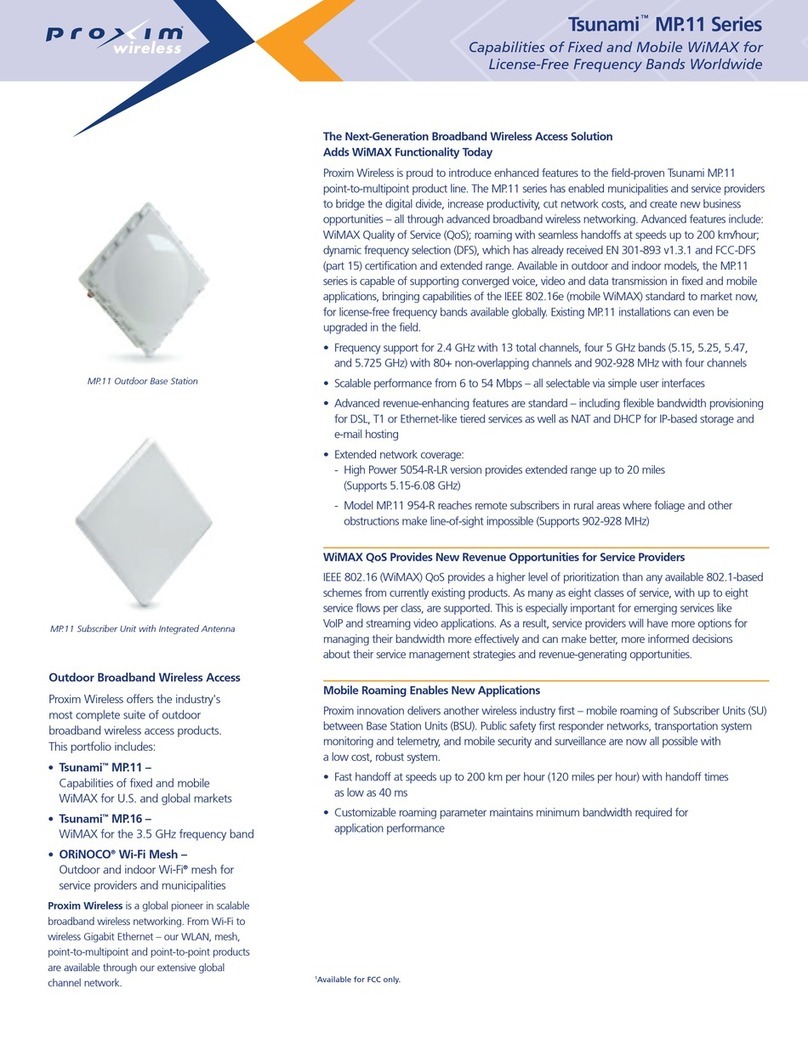
Proxim
Proxim Antenna Tsunami MP.11 User manual

